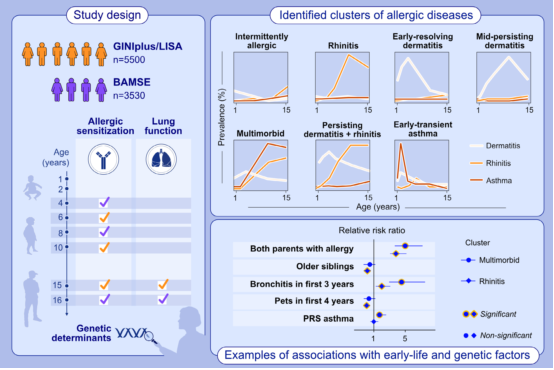Release date:2023-03-20

Allergy
[IF:13.146]
Allergic disease trajectories up to adolescence: Characteristics,early-life, and genetic determinantsDOI: 10.1111/all.15511
Abstract:
Background: Allergic diseases often develop jointly during early childhood but differ in timing of onset, remission, and progression. Their disease course over time is often difficult to predict and determinants are not well understood.
Objectives: We aimed to identify trajectories of allergic diseases up to adolescence and to investigate their association with early-life and genetic determinants and clinical characteristics.
Methods: Longitudinal k-means clustering was used to derive trajectories of allergic diseases (asthma, atopic dermatitis, and rhinitis) in two German birth cohorts (GINIplus/LISA). Associations with early-life determinants, polygenic risk scores, food and aeroallergen sensitization, and lung function were estimated by multinomial models.The results were replicated in the independent Swedish BAMSE cohort.
Results: Seven allergic disease trajectories were identified: “Intermittently allergic,” “rhinitis,” “early-resolving dermatitis,” “mid-persisting dermatitis,” “multimorbid,” “persisting dermatitis plus rhinitis,” and “early-transient asthma.” Family history of allergies was more prevalent in all allergic disease trajectories compared the non-allergic controls with stronger effect sizes for clusters comprising more than one allergic disease(e.g., RRR = 5.0, 95% CI = [3.1–8.0] in the multimorbid versus 1.8 [1.4–2.4] in the mild intermittently allergic cluster). Specific polygenic risk scores for single allergic diseases were significantly associated with their relevant trajectories. The derived trajectories and their association with genetic effects and clinical characteristics showed similar results in BAMSE.
Conclusion: Seven robust allergic clusters were identified and showed associations with early life and genetic factors as well as clinical characteristics.
First Author:
Anna Kilanowski
Corresponding author:
Marie Standl
Correspondence:
Marie Standl, Helmholtz Zentrum München –Deutsches Forschungszentrum für Gesundheit und Umwelt (GmbH),Institute of Epidemiology, Ingolstädter Landstraße 1, D-85764 Neuherberg, Germany.
Email: marie.standl@helmholtz-muenchen.de
 hth官方网页版中国有限公司
hth官方网页版中国有限公司
